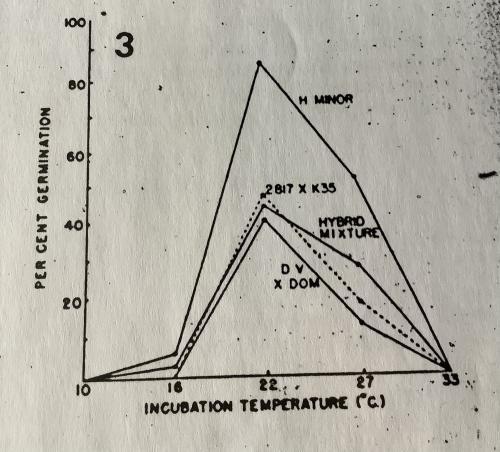bobjax said:
Amazing info. Thanks!
You know about hypotheses. Sometimes they are right; sometimes they are wrong or partially right/wrong.So yes, at this moment I am hypothesizing "that the 25% that germinated immediately without stratification would (could) have been evergreen."

sooby said:
Commercial hydrogen peroxide is at a higher strength than the drug store version. I used the household hydrogen peroxide which is 3%, further dilutions shown below. The seed coat of a daylily seed is not impermeable to water, it doesn't need softening. The inhibiting effect is a membrane in one area underneath the seed coat according to Griesbach, which limits oxygen exchange.
So it's not like the kind of seed dormancy where a hard seed coat is the cause of seed dormancy. Hydrogen peroxide has been shown to break seed dormancy in some other seeds by a biochemical pathway/interaction, I don't remember exactly what was proposed. It has also been suggested that the H2O2 increases the amount of oxygen and assists in that way with other seeds.
Results after 18 days:
100% H2O2 soak = 13 germ 12 not germ
1:3 19 germ 6 not germ
1:5 13 germ 12 not germ
1:7 10 germ 15 not germ
1:9 10 germ 15 not germ
1:11 10 germ 15 not germ
1:13 9 germ 16 not germ
1:15 11 germ 14 not germ*
Plain water soak 2 germ 23 not germ*
Damp vermiculite 1 germ 24 not germ*
Control
Solutions for all changed for first time on 23rd August when counted.
Results after 4 weeks
100% H2O2 soak = 22 germ 3 not germ
1:3 25 germ 0 not germ
1:5 25 germ 0 not germ
1:7 20 germ 5 not germ
1:9 22 germ 3 not germ
1:11 23 germ 2 not germ
1:13 20 germ 5 not germ
1:15 18 germ 7 not germ
Plain water soak 4 germ 21 not germ
Damp vermiculite 7 germ 18 not germ
Control
From my notes: Weaker H2O2, water and vermiculite seedlings fewer but more advanced. H2O2 seems to break seed dormancy, speeding germination, but inhibit growth at least in the solution. Seedlings were not grown on to see if this was a permanent effect.
Going back to evergreen versus deciduous ("dormant") daylily's seeds, if it was the case that seed dormancy was related to foliage habit of either the parents or the future foliage habit of the seedling, then why do a percentage of seeds from the same parent x same parent germinate immediately and some not for some time unless stratified?
In the tests I did the seeds were from a selfed deciduous species-type daylily. Are you implying that the 25% that germinated immediately without stratification would have been evergreen?
admmad said:@bobjax
I am going to introduce the other catch with evergreen versus "dormant".
sooby said:
And then for an evergreen: Hemerocallis fulva var. littorea seeds germinated at 50% without stratification, and at 95% with stratification.
sooby said:
Stratification in damp perlite in a fridge would normally be for 3-4 weeks but some may respond faster (or need longer).
One thing I also tested that did not work all that well was soaking in H2O2:water in the fridge.
Here is a catch for you.I crossed every flower of a Bogie and Becall (SEV) with every flower on a Happy Return (Dormant). Half the pods dropped at the beginning. Ended up with way over 300 seeds at the end. Almost all from one parent got damp off. Of the remaining, roughly another half, were pulled because of rust (kept one with mild rust). All those that remained were evergreens (Not SEVs; no dormants).
sooby said:
And then for an evergreen: Hemerocallis fulva var. littorea seeds germinated at 50% without stratification, and at 95% with stratification.
admmad said:@bobjax
If the same crosses were made in Florida would the seeds not show seed dormancy because they were from "evergreen" crosses or because of the environment that they experience while developing in Florida?
admmad said:
My basic assumption is that a daylily that is registered as "semi-evergreen" is actually able to become "dormant", unlike a daylily that is registered as "evergreen" which should not be able to become "dormant" - but apparently most of those are also able to become "dormant" and do so in appropriate locations/environments.
sooby said: Some daylilies registered as evergreen in warmer winter areas set dormant overwintering buds below the ground here and emerge as do the deciduous daylilies, with two short outer leaves like "bud scales".
admmad said:@bobjax
How do the daylilies that are registered as SEV and that you consider are SEV respond to winter in your garden?
1) Do they have a full fan of green leaves at the start of winter and some of the leaves yellow and die with time?
2) Do they grow new leaves during winter but when there is a freeze some of the leaves die and are replaced by new leaves?
3) Do they not grow any new leaves during winter, so that as the leaves die they become more like "dormant" daylilies and are almost entirely underground?
Presumably, daylilies that you consider are "evergreen" grow full, adult length fans of leaves during winter, and the leaves are undamaged by freezes?